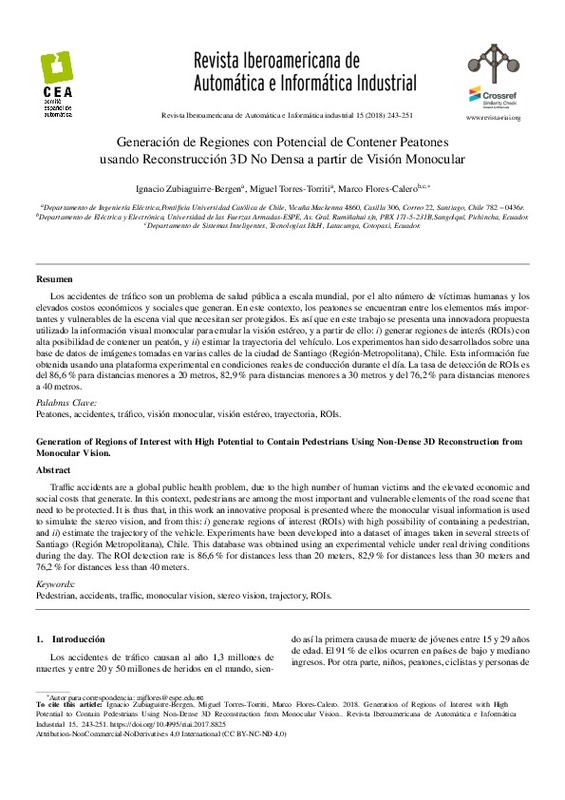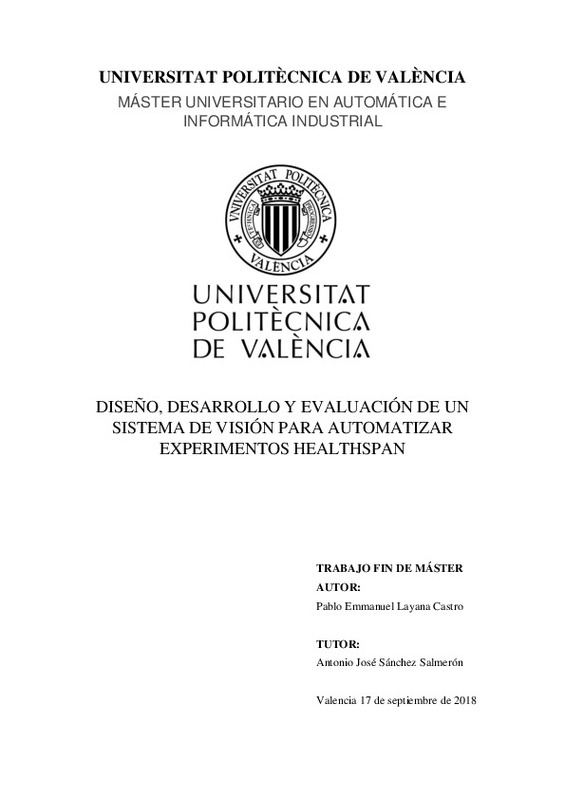JavaScript is disabled for your browser. Some features of this site may not work without it.
Buscar en RiuNet
Listar
Mi cuenta
Estadísticas
Ayuda RiuNet
Admin. UPV
Generación de Regiones con Potencial de Contener Peatones usando Reconstrucción 3D No Densa a partir de Visión Monocular
Mostrar el registro sencillo del ítem
Ficheros en el ítem
| dc.contributor.author | Zubiaguirre-Bergen, Ignacio
|
es_ES |
| dc.contributor.author | Torres-Torriti, Miguel
|
es_ES |
| dc.contributor.author | Flores-Calero, Marco
|
es_ES |
| dc.date.accessioned | 2020-05-13T19:22:28Z | |
| dc.date.available | 2020-05-13T19:22:28Z | |
| dc.date.issued | 2018-06-22 | |
| dc.identifier.issn | 1697-7912 | |
| dc.identifier.uri | http://hdl.handle.net/10251/143089 | |
| dc.description.abstract | [EN] Traffic accidents are a global public health problem, due to the high number of human victims and the elevated economic and social costs that generate. In this context, pedestrians are among the most important and vulnerable elements of the road scene that need to be protected. It is thus that, in this work an innovative proposal is presented where the monocular visual information is used to simulate the stereo vision, and from this :i) generate regions of interest (ROIs) with high possibility of containing a pedestrian, and ii) estimate the trajectory of the vehicle. Experiments have been developed into a dataset of images taken in several streets of Santiago (Región Metropolitana), Chile. This database was obtained using an experimental vehicle under real driving conditions during the day. The ROI detection rate is 86;6 % for distances less than 20 meters, 82;9 % for distances less than 30 meters and76;2 % for distances less than 40 meters. | es_ES |
| dc.description.abstract | [ES] Los accidentes de tráfico son un problema de salud pública a escala mundial, por el alto número de víctimas humanas y los elevados costos económicos y sociales que generan. En este contexto, los peatones se encuentran entre los elementos más importantes y vulnerables de la escena vial que necesitan ser protegidos. Es así que en este trabajo se presenta una innovadora propuesta utilizado la información visual monocular para emular la visión estéreo, y a partir de ello: i) generar regiones de interés (ROIs) con alta posibilidad de contener un peatón, y ii) estimar la trayectoria del vehículo. Los experimentos han sido desarrollados sobre una base de datos de imágenes tomadas en varias calles de la ciudad de Santiago (Región-Metropolitana), Chile. Esta información fue obtenida usando una plataforma experimental en condiciones reales de conducción durante el día. La tasa de detección de ROIs es del 86;6 % para distancias menores a 20 metros, 82;9 % para distancias menores a 30 metros y del 76;2 % para distancias menores a 40 metros. | es_ES |
| dc.description.sponsorship | Este proyecto ha sido financiado por la Comisión Nacional de Ciencia y Tecnología de Chile (Conicyt) a través del proyecto Fondecyt No. 11060251, por la Universidad de las Fuerzas Armadas-ESPE, a través del Plan de Movilidad con Fines de Investigación (Orden Rectorado 2017-109-ESPE-d), el proyecto de investigación Nro. 2014-PIT-007 y por la empresa Tecnologías I&H. | es_ES |
| dc.language | Español | es_ES |
| dc.publisher | Universitat Politècnica de València | es_ES |
| dc.relation.ispartof | Revista Iberoamericana de Automática e Informática industrial | es_ES |
| dc.rights | Reconocimiento - No comercial - Sin obra derivada (by-nc-nd) | es_ES |
| dc.subject | Pedestria | es_ES |
| dc.subject | Accidents | es_ES |
| dc.subject | Traffic | es_ES |
| dc.subject | Monocular vision | es_ES |
| dc.subject | Stereo vision | es_ES |
| dc.subject | Trajectory | es_ES |
| dc.subject | ROIs | es_ES |
| dc.subject | Peatones | es_ES |
| dc.subject | Accidentes | es_ES |
| dc.subject | Tráfico | es_ES |
| dc.subject | Visión monocular | es_ES |
| dc.subject | Visión estéreo | es_ES |
| dc.subject | Trayectoria | es_ES |
| dc.title | Generación de Regiones con Potencial de Contener Peatones usando Reconstrucción 3D No Densa a partir de Visión Monocular | es_ES |
| dc.title.alternative | Generation of regions of interest with high potential to contain pedestrians using non-dense 3D reconstruction from monocular vision | es_ES |
| dc.type | Artículo | es_ES |
| dc.identifier.doi | 10.4995/riai.2017.8825 | |
| dc.relation.projectID | info:eu-repo/grantAgreement/FONDECYT//11060251/ | es_ES |
| dc.relation.projectID | info:eu-repo/grantAgreement/ESPE//2017-109-ESPE-d/ | es_ES |
| dc.relation.projectID | info:eu-repo/grantAgreement/ESPE//2014-PIT-007/ | es_ES |
| dc.rights.accessRights | Abierto | es_ES |
| dc.description.bibliographicCitation | Zubiaguirre-Bergen, I.; Torres-Torriti, M.; Flores-Calero, M. (2018). Generación de Regiones con Potencial de Contener Peatones usando Reconstrucción 3D No Densa a partir de Visión Monocular. Revista Iberoamericana de Automática e Informática industrial. 15(3):243-251. https://doi.org/10.4995/riai.2017.8825 | es_ES |
| dc.description.accrualMethod | OJS | es_ES |
| dc.relation.publisherversion | https://doi.org/10.4995/riai.2017.8825 | es_ES |
| dc.description.upvformatpinicio | 243 | es_ES |
| dc.description.upvformatpfin | 251 | es_ES |
| dc.type.version | info:eu-repo/semantics/publishedVersion | es_ES |
| dc.description.volume | 15 | es_ES |
| dc.description.issue | 3 | es_ES |
| dc.identifier.eissn | 1697-7920 | |
| dc.relation.pasarela | OJS\8825 | es_ES |
| dc.contributor.funder | Fondo Nacional de Desarrollo Científico y Tecnológico, Chile | es_ES |
| dc.contributor.funder | Universidad de las Fuerzas Armadas ESPE, Ecuador | es_ES |
| dc.contributor.funder | Tecnologías I&H | es_ES |
| dc.description.references | Agencia Nacional de Tránsito del Ecuador, 2016. Siniestros octubre 2015. URL: http://www.ant.gob.ec/index.php/descargable/file/3368-siniestros-diciembre-2015 | es_ES |
| dc.description.references | Bouguet, Jean-Yves, 2015. Camera calibration toolbox for matlab. URL: http://www.vision.caltech.edu/bouguetj/calib_doc/ | es_ES |
| dc.description.references | CONASET, 2014. Informes de peatones. URL: http://www.conaset.cl/informes-peatones/ | es_ES |
| dc.description.references | Dalal, N., 2006. Finding people in images and videos. Ph.D. Thesis, Institut National Polytechnique de Grenoble. | es_ES |
| dc.description.references | Ess, A., Leibe, B., Schindler, K., , van Gool, L., June 2008. A mobile vision system for robust multi-person tracking. In: IEEE Conference on Computer Vision and Pattern Recognition (CVPR'08). IEEE Press. https://doi.org/10.1109/CVPR.2008.4587581 | es_ES |
| dc.description.references | Fischler, M., Bolles, R., 1981. Random sample consensus: a paradigm for model fitting with applications to image analysis and automated cartography. Communications of the ACM 24 (6), 381-395. https://doi.org/10.1145/358669.358692 | es_ES |
| dc.description.references | Flores-Calero, M., Armingol, A., de-la Escalera, A., july 2010. Driver drowsiness warning system using visual information for both diurnal and nocturnal illumination conditions. EURASIP journal on advances in signal processing 2010 (3). https://doi.org/10.1155/2010/438205 | es_ES |
| dc.description.references | Flores-Calero, M., Armingol, A., de-la Escalera, A., 2011. Sistema Avanzado de Asistencia a la Conducción para la Detección de la Somnolencia. Revista Iberoamericana de Automática e Informática Industrial 8 (3), 216-228. https://doi.org/10.1016/j.riai.2011.06.009 | es_ES |
| dc.description.references | Flores-Calero, M., Robayo, D., Saa, D., May 2015. Histograma del gradiente con múltiples orientaciones (HOG-MO): Detección de personas. Revista Vínculos 12 (2), 138-147. | es_ES |
| dc.description.references | Forsyth, D. A., Ponce, J., 2003. Computer Vision, A Modern Approach, 1st Edition. Prentice Hall. | es_ES |
| dc.description.references | Fundación MAFRE, 2012. Datos de seguridad vial. URL: https://www.profesoresyseguridadvial.com/colombia-datos-de-seguridad-vial/ | es_ES |
| dc.description.references | Horgan, J., Hughes, C., McDonald, J., Yogamani, S., 2015. Vision-Based Driver Assistance Systems: Survey, Taxonomy and Advances. In: IEEE 18th International Conference on Intelligent Transportation Systems (ITSC). pp. 2032-2039. https://doi.org/10.1109/ITSC.2015.329 | es_ES |
| dc.description.references | Keller, C., Enzweiler, M., Gavrila, D., July 2011. A new benchmark for stereobased pedestrian detection. In: IEEE Intelligent Vehicles Symposium (IV). pp. 691-696. | es_ES |
| dc.description.references | Kohler, S., Goldhammer, M., Zindler, K., Doll, K., Dietmeyer, K., September 2015. Stereo-vision-based pedestrian's intention detection in a moving vehicle. In: 2015 IEEE 18th International Conference on Intelligent Transportation Systems. pp. 2317-2322. https://doi.org/10.1109/ITSC.2015.374 | es_ES |
| dc.description.references | La Tercera, 2014. Chile es el país con mayor tasa de peatones fallecidos entre los países de la OCDE. URL: http://www.latercera.com/noticia/nacional/2014/10/680-601399-9-chile-//es-el-pais-con-mayor-tasa-de-peatones-fallecidos-entre-//los-paises-de-la.shtml | es_ES |
| dc.description.references | Li, X., Flohr, F., Yang, Y., Xiong, H., Braun, M., Pan, S., Li, K., Gavrila, D. M., June 2016. A new benchmark for vison-based cyclist detection. In: IEEE Intelligent Vehicles Symposium. pp. 1109-1114. | es_ES |
| dc.description.references | Ma, G., Muller, D., Park, S.-B., Muller-Schneiders, S., Kummert, A., march 2009. Pedestrian detection using a single monochrome camera. Intelligent Transport Systems, IET 3 (1), 42 -56. https://doi.org/10.1049/iet-its:20080001 | es_ES |
| dc.description.references | Mammeri, A., Zuo, T., Boukerche, A., April 2016. Extending the Detection Range of Vision-Based Vehicular Instrumentation. IEEE Transactions on Instrumentation and Measurement 65 (4), 856-873. https://doi.org/10.1109/TIM.2016.2514780 | es_ES |
| dc.description.references | Mesmakhosroshahi, M., Chung, K.-H., Lee, Y., Kim, J., November 2014. Depth gradient based region of interest generation for pedestrian detection. In: IEEE International Conference on SoC Design (ISOCC). pp. 156-157. https://doi.org/10.1109/ISOCC.2014.7087674 | es_ES |
| dc.description.references | Min, K., Son, H., Choe, Y., Kim, Y., June 2013. Real-time pedestrian detection based on a hierarchical two-stage support vector machine. In: IEEE 8th Conference on Industrial Electronics and Applications (ICIEA). pp. 114-119. | es_ES |
| dc.description.references | Oikawaa, S., Matsuia, Y., Doib, T., Sakuraic, T., February 2016. Relation between vehicle travel velocity and pedestrian injury risk in different age groups for the design of a pedestrian detection system. Safety Science 82, 361-367. https://doi.org/10.1016/j.ssci.2015.10.003 | es_ES |
| dc.description.references | Overett, G., Petersson, L., Brewer, N., Andersson, L., Pettersson, N., 2008. A new pedestrian dataset for supervised learning. URL: https://research.csiro.au/data61/automap-datasets-and-code/ | es_ES |
| dc.description.references | Russell, B. C., Torralba, A., Murphy, K. P., Freeman, W. T., May 2008. Label me, a database and web-based tool for image annotation. International Journal of Computer Vision (1-3). URL: http://labelme.csail.mit.edu/ | es_ES |
| dc.description.references | Shi, J., Tomasi, C., jun 1994. Good features to track. In: Computer Vision and Pattern Recognition, 1994. Proceedings CVPR '94., 1994 IEEE Computer Society Conference on. pp. 593 -600. https://doi.org/10.1109/CVPR.1994.323794 | es_ES |
| dc.description.references | Shou, N., Peng, H., Wang, H., Meng, L.-M., Du, K.-L., Octuber 2012. An rois based pedestrian detection system for single images. | es_ES |
| dc.description.references | Tetik, Y., Bolat, B., June 2011. Pedestrian detection from still images. In: IEEE International Symposium on Innovations in Intelligent Systems and Applications (INISTA). pp. 540-544. | es_ES |
| dc.description.references | Villalón-Sepúlveda, G., Torres-Torriti, M., Flores-Calero, M., May 2017. Traffic Sign Detection System for Locating Road Intersections and Roundabouts: The Chilean Case. Sensors MDPI 17 (6), 138-147. https://doi.org/10.3390/s17061207 | es_ES |
| dc.description.references | Wang, L., Shi, J., Song, G., Shen, I.-f., 2007. Object detection combining recognition and segmentation. URL: https://www.cis.upenn.edu/~jshi/ped_html/ | es_ES |
| dc.description.references | Wang, X., Wang, M., Li, W., December 2014. Scene-Specific Pedestrian Detection for Static Video Surveillance. IEEE Transactions on Pattern Analysis and Machine Intelligence 36, 361-374. https://doi.org/10.1109/TPAMI.2013.124 | es_ES |
| dc.description.references | World Health Organization WHO, 2015. Road traffic injuries. | es_ES |
| dc.description.references | Yuan, Y., Lin, W., Fang, Y., September 2015. Is pedestrian detection robust for surveillance? In: Image Processing (ICIP), 2015 IEEE International Conference on. pp. 2776 - 2780. | es_ES |
| dc.description.references | Zhang, C., Chung, K.-H., Kim, J., November 2015a. Region-of-interest reduction using edge and depth images for pedestrian detection in urban areas. | es_ES |
| dc.description.references | Zhang, X., Hu, H.-M., Jiang, F., Li, B., May 2015b. Pedestrian detection based on hierarchical co-occurrence model for occlusion handling. Neurocomputing 168, 861-870. https://doi.org/10.1016/j.neucom.2015.05.038 | es_ES |
| dc.description.references | Zhang, Z., Tao, W., Sun, K., Hu, W., Yao, L., May 2016. Pedestrian detection aided by fusion of binocular information. Pattern Recognition 60, 227-238. https://doi.org/10.1016/j.patcog.2016.05.006 | es_ES |
| dc.description.references | Zhao, X., Ye, M., Zhu, Y., Zhong, C., Zhou, J., December 2009. Real time roi generation for pedestrian detection. | es_ES |










